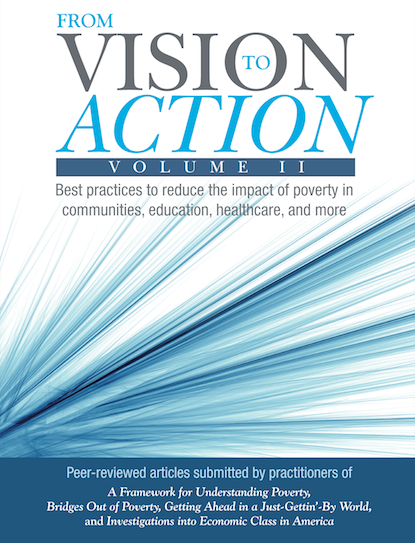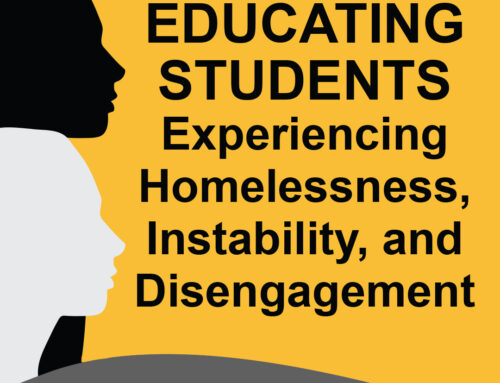 New book, From Vision to Action II: Best Practices to Reduce the Impact of Poverty in Communities, Education, Healthcare, and More, showcases results of individuals, organizations, and communities
New book, From Vision to Action II: Best Practices to Reduce the Impact of Poverty in Communities, Education, Healthcare, and More, showcases results of individuals, organizations, and communities
Highlands, Texas – Jan. 14, 2015 – After spending $22 trillion dollars over 50 years, the War on Poverty has not materially moved the needle. But hospitals, schools, churches, social service agencies, prison re-entry programs, and other groups around the country are achieving measurable results. They are focusing on the root causes of poverty to break the cycle of generational poverty and drive self-sufficiency.
- A Lancaster County, Pennsylvania school, Pequea Valley Intermediate, shifted its Title I spending to focus on parents – equipping them to be self-sufficient. Its children are showing declines in absenteeism and disciplinary referrals, and improved test scores.
- After years of funding initiatives that produced few results, the City of Muskogee (Oklahoma) Foundation passed a city resolution selecting a Bridges Out of Poverty initiative and the award-winning Getting Ahead in a Just-Gettin’-By World curriculum that engages people from poverty. The investment transformed lives and launched a statewide initiative.
- In Schenectady, New York, Ellis Medicine opened an effective and thriving outpatient campus that focused on the dual needs of people in poverty, easily accessible and all- encompassing healthcare services, while meeting the hospital’s need for financial sustainability.
- Habitat for Humanity of Greater Charlottesville, Virginia applied the Bridges Out of Poverty approach to launch viable community-wide initiatives. Instead of building single homes, the nonprofit has transformed whole areas of town into vibrant and diverse mixed- income and mixed-use neighborhoods.These and other stories are contained in the new book, From Vision to Action II: Best Practices to Reduce the Impact of Poverty in Communities, Education, Healthcare, and More. Written by individuals on the front lines, the book features 12 programs that truly move the needle by using the Bridges Out of Poverty framework.“From Vision to Action II will inspire and inform groups across the nation looking for ways to work together to alleviate poverty,” said Philip E. DeVol, noted consultant and expert on poverty issues. “The book shares best practices and successes from Bridges communities across the country,” said DeVol, co-author of the award-winning Getting Ahead in a Just-Gettin’-By World: Building Your Resources for a Better Life and Bridges Out of Poverty: Strategies for Professionals and Communities.
Bridges Out of Poverty helps local communities, educators, healthcare providers, and businesses address the challenges of poverty and improve lives. Bridges Out of Poverty principles are being used by over 250 communities across all 50 states to combat poverty at the individual, community, and institutional levels to support the nearly 50 million Americans living in poverty.
“The majority of money spent federally on poverty simply goes to maintenance,” said Dr. Ruby K. Payne, president of aha! Process. “Bridges helps individuals, institutions, and communities do more by investing resources in a ‘triple lens approach’ that provides the tools and training to help individuals in poverty and the agencies that support them.”
aha! Process is a consulting and training company that works across all sectors of a community to address the root causes of poverty, support individuals as they build resources, and achieve a sustainable community where everyone can live well. For more than 15 years, Bridges Out of Poverty constructs have helped communities and organizations around the world eliminate barriers for thousands of under-resourced individuals.
To order From Vision to Action II: Best Practices to Reduce the Impact of Poverty in Communities, Education, Healthcare, and More, visit www.ahaprocess.com/store.
About aha! Process:
aha! Process is an award-winning training and publishing company that works across all sectors of a community to address the root causes of poverty, support individuals as they build resources, and achieve a sustainable community where everyone can live well. They have worked with thousands of schools, employers, hospitals, colleges, first responders, judges, and community organizations, providing concrete strategies and proven tools to help under-resourced individuals thrive. This work leverages more than 15 years of experience strengthened by a growing body of knowledge from communities using and adapting our model. These programs help institutions and communities understand the mindsets of people in poverty and engage with them to build success.
Media Contact:
For interviews or to request a preview copy of the book, media members may contact:
Name: Chase Pattillo
Email: cpattillo@ahaprocess.com
Phone: (832) 514-2689








